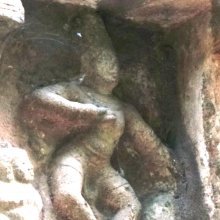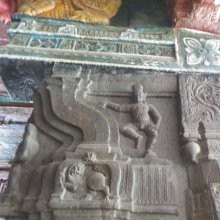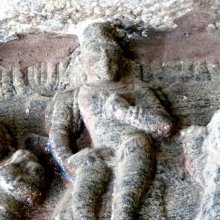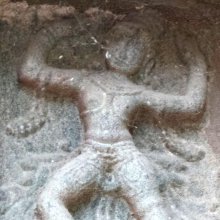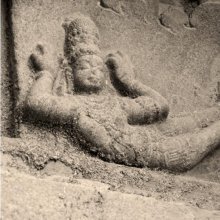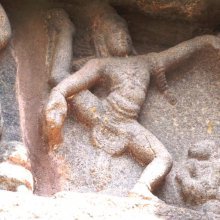Recita: 14 definitions
Introduction:
Recita means something in Hinduism, Sanskrit, Jainism, Prakrit, Marathi. If you want to know the exact meaning, history, etymology or English translation of this term then check out the descriptions on this page. Add your comment or reference to a book if you want to contribute to this summary article.
Alternative spellings of this word include Rechita.
Images (photo gallery)
(+41 more images available)
In Hinduism
Natyashastra (theatrics and dramaturgy)
Source: Wisdom Library: Nāṭya-śāstra1a) Recita (रेचित).—One of the 32 aṅgahāras (major dance movement) mentioned in the Nāṭyaśāstra chapter 4.
(Instructions): “showing Recita hand, bending it on one side and making the same recita movement and then repeating this movement after bending the entire body, assuming successively Nūpurapādā, Bhujaṅgatrāsita, Recita, Uromaṇḍala and Kaṭicchinna Karaṇas.”.
An aṅgahāra represents a ‘major dance movement’ and consists of a sequence of karaṇas (minor dance movements). A karaṇa combines sthāna (standing position), cārī (foot and leg movement) and nṛttahasta (hands in dancing position).
1b) Recita (रेचित, “moving”) refers to a specific gesture (āṅgika) made with the eyebrows (bhrū), according to the Nāṭyaśāstra chapter 8. These gestures of the eyelids (puṭa) are supposed to be performed in accordance with the corresponding gestures of the eyeballs (tārā) and the eyelids (puṭa). These gestures form a part of the histrionic representation (abhinaya).
(Instructions): “raising of one of the eyebrows in an amorous way”. Uses: “in dance (nṛtta)”.
1c) Recita (रेचित) also refers to a gesture (āṅgika) made with ‘dance hands’ (nṛttahasta), according to the Nāṭyaśāstra chapter 8. The hands (hasta) form a part of the human body which represents one of the six major limbs (aṅga) used in dramatic performance. With these limbs are made the various gestures (āṅgika).
(Instructions): “the two haṃsapakṣa hands swiftly moving with the palms facing upward. This is like the ordinary recita of the hands”. (Uses): “the dance-hands are to be used in forming karaṇas”.
1d) Recita (रेचित) refers to one of the thirty-three alaṃkāras (embellishments), according to the Nāṭyaśāstra chapter 29. These alaṃkāras, or, ‘embellishments of song’, depend upon the four types of varṇas, which refers to a specific order of musical notes (svara). They are attached to the songs of seven forms, although not generally used in the dhruvās.
According to the Nāṭyaśāstra, “recita is trembling notes of three kalās in high pitch (lit. in the head)”.
2a) Recitā (रेचिता, “purged”) refers to a specific gesture (āṅgika) made with the neck (grīvā), according to the Nāṭyaśāstra chapter 8. These ‘gestures of the neck (grīvā)’ should follow the gestures made with the head (śiras).
(Instructions): “the neck shaken or moved”. Uses: “in emotion (hāva), churning and dance”.
2b) Recitā (रेचिता, “moved about”) refers to a specific ‘movement of the waist’ (kaṭi), according to the Nāṭyaśāstra chapter 10. The waist is one of the six major limbs (aṅga) used to perform certain gestures (āṅgika).
(Instructions): “in moving in all directions”. Uses: “in movements of the general type”.
Source: archive.org: The mirror of gesture (abhinaya-darpana)1) One of six movements of the Brows: Recita: one brow is contracted with charm and sweetness. Usage: listening to a secret, saying “Sādhu”, looking at any place.
2) One of the hasta-prāṇa, or ‘Twelve Lives of the Hands’: Recita (separated): separating the fingers.
3) One of the saṃyutta-hastāni (Twenty-six combined Hands).—Recita: Haṃsa-pakṣa hands face upwards, held apart. Patron deity Yakṣarāja. Usage: holding children, showing a painted panel (citra-phalaka).
4) Recita is one of the saṃyutta-hastāni (Twenty-seven combined Hands).
Source: archive.org: Illustrations of Indian Music and Dance in Western Indian Style (natya)Recita (रेचित) refers to “raising one eye-bow gracefully”, and is classified as one of the seven movements of the eye-brows, which forms a part of upāṅga (minor body-parts) in Nāṭyaśāstra. Recita can be used in dancing.
Source: Shodhganga: Elements of Art and Architecture in the Trtiyakhanda of the Visnudharmottarapurana (natya)1) Recitā (रेचिता) refers to one of the “five movements of the waist” (in Sanskrit Dramas), as conveyed through Āṅgikābhinaya: one of the four divisions of Abhinaya or “ways to convey or represent one’s emotion to others”, according to the Viṣṇudharmottarapurāṇa, an ancient Sanskrit text which (being encyclopedic in nature) deals with a variety of cultural topics such as arts, architecture, music, grammar and astronomy.—The āṅgikābhinaya includes the histrionic representation of the limbs which is simply known as physical gestures. The Viṣṇudharmottarapurāṇa seems to take the word kaṭi in feminine gender and makes the divisions of waist movements in feminine gender. Recitā should be adopted in going for a walk and udvāhitā should be taken in sportive movement by uplifting the waist part in a certain way.
2) Recita (रेचित) refers to one of the thirty Nṛttahastas or “dance hand gestures” (in Indian Dramas), according to the Viṣṇudharmottarapurāṇa.—The hasta-mudrās (lit. “hand-gestures”) are very essential to denote some particular action or state in dancing and these mudrās are formed with the help of hands and fingers. In the Viṣṇudharmottarapurāṇa, thirty kinds of nṛttahastas (“dance-hand gestures”) are mentioned. e.g., recita. The practice of these nṛttahastas is strictly prohibited in sickness of body, in old age, in fear, drunk and anxiety.
3) Recita (रेचित) refers to one of the 108 kinds of Karaṇa (“coordination of precise movements of legs and hands”), according to the Viṣṇudharmottarapurāṇa.—Accordingly, karaṇas are the coordination of precise movements of legs and hands performed in a particular posture. The Nāṭyaśāstra also gives its view point in the same spirit. In the Viṣṇudharmottarapurāṇa, one hundred and eight kinds of karaṇas are accepted, e.g., Recita.

Natyashastra (नाट्यशास्त्र, nāṭyaśāstra) refers to both the ancient Indian tradition (shastra) of performing arts, (natya—theatrics, drama, dance, music), as well as the name of a Sanskrit work dealing with these subjects. It also teaches the rules for composing Dramatic plays (nataka), construction and performance of Theater, and Poetic works (kavya).
General definition (in Hinduism)
Source: Academia.edu: Some Pearls from the Fourth Chapter of Abhinavabhāratī Table of ContentsThe term Recita (रेचित, “relating to a limb”) means moving it round separately (i.e., not in any karaṇa or cārī) or its drawing up or its movement of any kind, separately.
In Jainism
General definition (in Jainism)
Source: archive.org: TrisastisalakapurusacaritraRecita (रेचित) (also Uttejita) refers to one of the five gaits of a horse which is a “gait with moderate speed”.—The Abhidhānacintāmaṇi 4.312-315 enumerates the 5 gaits of a horse; dhorita, ‘like a mongoose, heron, peacock, or boar’; valgita, which seems to be ‘gallop’; pluta or plaṅghana, ‘resembling the gait of a bird ox deer’; uttejita or recita, ‘a gait with moderate speed’; utterita, or upakaṇṭha, or āskandita, ‘jumping with all the feet as if in anger,’ apparently ‘bucking’.

Jainism is an Indian religion of Dharma whose doctrine revolves around harmlessness (ahimsa) towards every living being. The two major branches (Digambara and Svetambara) of Jainism stimulate self-control (or, shramana, ‘self-reliance’) and spiritual development through a path of peace for the soul to progess to the ultimate goal.
Languages of India and abroad
Marathi-English dictionary
Source: DDSA: The Molesworth Marathi and English Dictionaryrēcita (रेचित).—p S Purged. 2 Emptied.
Marathi is an Indo-European language having over 70 million native speakers people in (predominantly) Maharashtra India. Marathi, like many other Indo-Aryan languages, evolved from early forms of Prakrit, which itself is a subset of Sanskrit, one of the most ancient languages of the world.
Sanskrit dictionary
Source: DDSA: The practical Sanskrit-English dictionaryRecita (रेचित).—a. Emptied, cleared; किरातसैन्यैरपिधाय रेचिताः (kirātasainyairapidhāya recitāḥ) Kirātārjunīya 14.33; ववलिरे वलिरेचितमध्यमाः (vavalire valirecitamadhyamāḥ) Śiśupālavadha 6.38.
-tam horse's gallop.
Source: Cologne Digital Sanskrit Dictionaries: Shabda-Sagara Sanskrit-English DictionaryRecita (रेचित).—mfn.
(-taḥ-tā-taṃ) 1. Left void or empty, freed from, cleared. 2. Purged. n.
(-taṃ) A horse’s gallop. E. ric to purge, kta aff.
Source: Cologne Digital Sanskrit Dictionaries: Monier-Williams Sanskrit-English Dictionary1) Recita (रेचित):—[from ric] a etc. See p. 887, col. 1.
2) [from reka] b mfn. ([from] [Causal]) emptied, purged, cleared, [Horace H. Wilson]
3) [v.s. ...] left, abandoned, [Raghuvaṃśa; Śiśupāla-vadha]
4) [v.s. ...] m. ([scilicet] hasta) Name of a [particular] position of the hands in dancing, [Catalogue(s)]
5) Recitā (रेचिता):—[from recita > reka] f. contraction of one eye-brow, [cf. Lexicographers, esp. such as amarasiṃha, halāyudha, hemacandra, etc.]
6) Recita (रेचित):—[from reka] n. Name of one of a horse’s paces, cantering, [Kādambarī]
Source: Cologne Digital Sanskrit Dictionaries: Yates Sanskrit-English DictionaryRecita (रेचित):—[(taḥ-tā-taṃ) p.] Left; purged.
[Sanskrit to German]
Sanskrit, also spelled संस्कृतम् (saṃskṛtam), is an ancient language of India commonly seen as the grandmother of the Indo-European language family (even English!). Closely allied with Prakrit and Pali, Sanskrit is more exhaustive in both grammar and terms and has the most extensive collection of literature in the world, greatly surpassing its sister-languages Greek and Latin.
Kannada-English dictionary
Source: Alar: Kannada-English corpusRēcita (ರೇಚಿತ):—[adjective] emptied; poured out (of all the contents from within).
--- OR ---
Rēcita (ರೇಚಿತ):—
1) [noun] one of gaits of a horse.
2) [noun] (dance.) a moving of both the palms towards the front of the chest, with elbows stretched out, and turning palms upward, with stretched fingers of one palm pointing at the stretched fingers of the other.
3) [noun] (dance.) a moving of the head with a sudden and short jerk.
4) [noun] (dance.) a particular mode in turning one’s neck.
Kannada is a Dravidian language (as opposed to the Indo-European language family) mainly spoken in the southwestern region of India.
See also (Relevant definitions)
Starts with: Recitahasta, Recitanikuttita, Recitation.
Ends with: Adhikodrecita, Akshiptarecita, Ardharecita, Arecita, Bhujangatrastarecita, Chinnavrishcikarecita, Damdarecita, Dandakarecita, Grivarecita, Katirecita, Padarecita, Parivrittakarecita, Parivrittarecita, Svastikarecita, Uttanarecita, Vaishakharecita, Virecita, Vrishcikarecita.
Full-text (+45): Ardharecita, Virecita, Kati, Arecitabhru, Durakicala, Arecita, Paravaca, Pancagati, Uttanarecita, Akshiptarecita, Irecitam, Nrittahasta, Uttejita, Parivrittarecita, Vaishakharecita, Abhirata, Samyutta-hastani, Griva, Vishnukranta, Vivartitaka.
Relevant text
Search found 9 books and stories containing Recita, Recitā, Rēcita; (plurals include: Recitas, Recitās, Rēcitas). You can also click to the full overview containing English textual excerpts. Below are direct links for the most relevant articles:
Amarakoshodghatana of Kshirasvamin (study) (by A. Yamuna Devi)
Fauna (5): Domesticated Animals (b): Horse (Aśva) < [Chapter 5 - Aspects of Nature]
Fauna (5): Domesticated animals (d): Cow < [Chapter 5 - Aspects of Nature]
Gati in Theory and Practice (by Dr. Sujatha Mohan)
Gati in vehicles < [Chapter 3 - Application of gati in Dṛśya-kāvyas]
Elements of Āṅgika-abhinaya in Nāṭyaśāstra < [Chapter 1 - Nāṭya]
Gati pertaining to conditions and situations < [Chapter 3 - Application of gati in Dṛśya-kāvyas]
Natyashastra (English) (by Bharata-muni)
Chapter IV - Description of the Class Dance (tāṇḍava)
Chapter X - Gestures of other Limbs
Abhinaya-darpana (English) (by Ananda Coomaraswamy)
Chapter 9 - Six Movements of the Brows
Chapter 11 - Lives of the Hands
Vishnudharmottara Purana (Art and Architecture) (by Bhagyashree Sarma)
1.3. Elements of Drama (c): Bodily Movements < [Chapter 3 - Drama and Dance]
2.2. Hand Postures (c): Nṛtta-hasta < [Chapter 3 - Drama and Dance]
2.5. Karaṇa (movements of legs and hands) < [Chapter 3 - Drama and Dance]
The Religion and Philosophy of Tevaram (Thevaram) (by M. A. Dorai Rangaswamy)
Chapter 4.3 - (c) Sculptures of Shiva and Dance < [Volume 2 - Nampi Arurar and Mythology]
